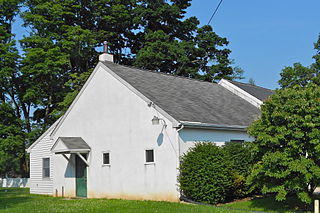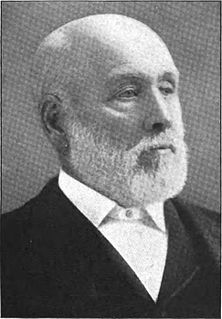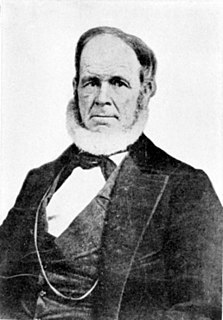
Salem is a city in Henry County, Iowa, United States. The population was 394 at the time of the 2020 census.

Benjamin Lundy was an American Quaker abolitionist from New Jersey of the United States who established several anti-slavery newspapers and traveled widely. He lectured and published seeking to limit slavery's expansion and tried to find a place outside the United States to establish a colony in which freed slaves might relocate.

Thomas Clarkson was an English abolitionist, and a leading campaigner against the slave trade in the British Empire. He helped found The Society for Effecting the Abolition of the Slave Trade and helped achieve passage of the Slave Trade Act 1807, which ended British trade in slaves.

Ellis Fuller Lawrence was an American architect who worked primarily in the U.S. state of Oregon. In 1914, he became the co-founder and first dean of the University of Oregon's School of Architecture and Allied Arts, a position he held until his death.

William Forster was a preacher, Quaker elder and a fervent abolitionist. He was an early member of the British and Foreign Anti-Slavery Society in 1839. It was William and Stephen Grellet who introduced Elizabeth Fry to her life's work with prisons, but it was William's brother, Josiah, who accompanied Fry on her tour and inspection of prisons in France.

The Coffin House is a National Historic Landmark located in the present-day town of Fountain City in Wayne County, Indiana. The two-story, eight room, brick home was constructed circa 1838–39 in the Federal style. The Coffin home became known as the "Grand Central Station" of the Underground Railroad because of its location where three of the escape routes to the North converged and the number of fleeing slaves who passed through it.

Lorenzo Dow Lewelling was the 12th Governor of Kansas.

Asahel Bush was an American newspaper publisher and businessman in Salem, Oregon. As publisher of the Oregon Statesman newspaper, he moved the paper to Salem when the territorial capital moved to that city. A Massachusetts native, Bush became the first official printer for the state of Oregon, and his estate is now a city park.

Thomas M'Clintock was an American pharmacist and a leading Quaker organizer for many reforms, including abolishing slavery, achieving women's rights, and modernizing Quakerism.

Ercildoun, population about 100, is an unincorporated community in East Fallowfield Township, Chester County, Pennsylvania, United States. The hamlet was founded by Quakers and was an early center of the abolitionist movement. In 1985 the entire hamlet, including 31 properties, was listed as a historic district on the National Register of Historic Places. Of these properties two were vacant land, 14 were significant buildings, ten were contributing buildings, and five buildings, built in the 1950s, were non-contributing. The Lukens Pierce House, an octagon house listed separately on the U.S. National Register of Historic Places, is located about half a mile northwest of the hamlet. Ercildoun is one of about ten hamlets in the township, which has no cities or towns, but has 31 sites listed on the National Register. It is one of the larger hamlets, located near the center of the township, and historically among the best known. The city of Coatesville is about 3 miles north.

Josiah Forster was an English teacher and philanthropist. He was an early member of the British and Foreign Anti-Slavery Society in 1839 and a supporter of the British and Foreign Bible Society. Both he and his wife were senior figures in the British Quakers.

The John Street House is a historic home in Salem, Ohio. It was a stop on the Underground Railroad.

The Daniel Howell Hise House is an historic home that was part of the Underground Railroad. It is listed on the National Register of Historic Places and is located in Salem, Ohio.

Joseph Hamilton Lambert, was an American pioneer of Oregon and an orchardist who developed the Lambert cherry. A native of Indiana, he also served as a county commissioner in Multnomah and Clackamas counties in Oregon.

Alan West Corson Homestead is a historic house located in Whitemarsh Township, Montgomery County, Pennsylvania. It was built in three sections between 1734 and 1820. It is a 2+1⁄2-story, stuccoed stone dwelling, six bays wide and two bays deep. It has a 2+1⁄2-story rear ell. Also on the property is a contributing smoke house. The property was used for one of the earliest area nurseries and a boarding school.

Hovenden House, Barn and Abolition Hall is a group of historic buildings in Plymouth Meeting, Whitemarsh Township, Montgomery County, Pennsylvania. In the decades prior to the American Civil War, the property served as an important station on the Underground Railroad. Abolition Hall was built to be a meeting place for abolitionists, and later was the studio of artist Thomas Hovenden.

Seth Lewelling, alternatively spelled Luelling, was a pioneer orchardist from the U.S. state of Oregon, best known for developing the Bing cherry. Born in 1820 in South Carolina as Seth Luelling, he used that spelling of his last name for part of his life but at some point changed it to Lewelling and favored that spelling for the last several years of his life.

The Collins-Bond House is a historic house located at 402 South Main Street in Salem, Iowa.

Henderson William Luelling was an American horticulturist, Quaker, abolitionist and early Oakland, California settler. He introduced varietal fruits to the Pacific coast, first to Oregon and later to California, and gave the Fruitvale district its name. In his later years, he led a Utopian community from California to Honduras, only to encounter overwhelming adversity, which sent him back to California.






















